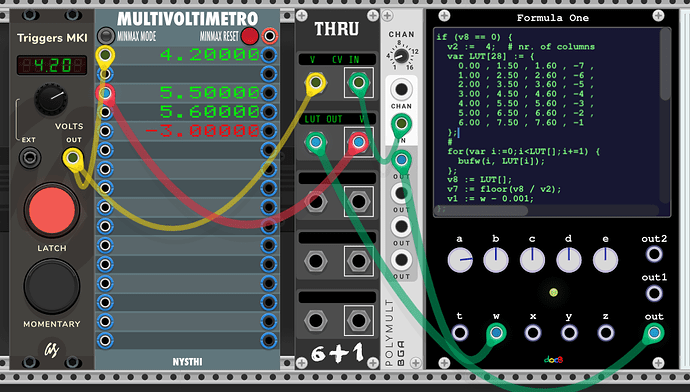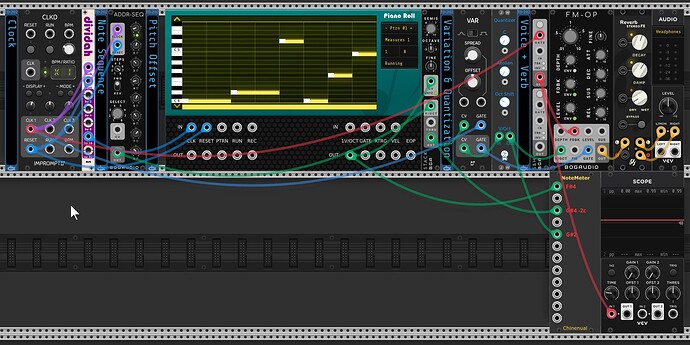I will play with STRIP++ again. It has been a while since I did and I cannot remember why I chose not to use it.
Well, STRIP++ does preserve CV-MAP mappings to ADDR-SEQ step knob params, as long as I remember exactly how to use STRIP++. I had to refer back to your post on how STRIP++ seems to work.
I suppose you are referring to this post.
A suggestion to @stoermelder: Maybe the STRIP++ manual would benefit from a modest expansion, because it is such a valuable module but not straightforward to use without more guidance.
Unfortunately, using CV-MAP setting up ADDR-SEQ to sequence AaronStatic DiatonicCV octave crashed rack and corrupted the patch such that it cannot be reloaded. Reload crashes Rack and the log file shows the fatal error in the Aaron Static plugin. I was able to reload the oatch since I had not saved the modified version, but all of that work is now gone, so, not sure how much farther I will take this. I have not had a Rack crash in a long-long time. I didn’t even get to using STRIP++ to load this selection this time.
yes.
I rebuilt the modified patch for DiatonicCV octave sequencing and it did not crash Rack this time. I will proceed with sequencing the other DiatonicCV parameters cautiosly.
I am so sorry that you have so much trouble. It does not even seem that you are doing anything precarious, which doubles the aggravation ![]() . Might be good to just turn off the machine for a while and take a mental break.
. Might be good to just turn off the machine for a while and take a mental break.
Turning off the machine is easy. Turning off my brain is another matter ![]()
LOL. I know how that feels… ![]()
I actually submitted an FR this morning to support to preserve MIDI mappings when hitting File->Import Selection. Pipe up to add your vote! The more the more likely it gets implemented.
Nice ambient pad patch (or rather selection ![]() ).
).
Great idea, thank you for taking the time! Actually, isn’t this a bug rather than a new feature?
I suspect that Andrew (understandably) is even more busy than 5 yrs ago. Can you provide a link to support the request?
There is no link, as this has to go via email to support. Simply state that you’s like to support the feature request to preserve MIDI mappings submitted yesterday by me, that should do it… I was on the fence between FR and bug, maybe state that you consider it a bug as well?
Done.
Shimmer Reverb.vcvs (10.0 KB)
Click-Free Audio Looper.vcvs (8.9 KB)
Here’s a couple I use a lot, DIY shimmer verb and a looping sub-patch with a short fade in/out. I like to loop stuff post-FX, so I can capture bits of granular delay and reverb tails without annoying clicks. Just connect whatever you want to loop into the Nysthi autoXfade inputs.
Both of them are very nice and useful, thank you!
Thanks, I’ll see what else I can dig out!
This is a useful selection I sometimes have in my patches:
lut_poly_f1.vcvs (4.1 KB)
CV LookUp Table using docB Formula One
Convert incoming CV ranges into discreet (multiple/polyphonic) output CV values using a predefined lookup table. The lookup table can be changed in the F1 code, using a list of comma separated values. Table lookup is implemented with a binary search algorithm, so it should be efficient, even for large lookup tables.
Usage:
- connect incoming CV to “w” input of F1
- connect it directly when having only one output value (remove BOG Polymult in that case)
- connect through BOG Polymult to F1’s “w” input when multiple output values in the lookup table, and set “CHAN” to the nr. of output channels
- in F1, replace “LUT” table definition with wanted values these can be values exported from a spreadsheet in Comma Separated Value (CSV) text format (note: no comma after last element!)
- first column contains input value ranges
- set “v2” to the nr. of columns in the table (= 1 + nr. of outputs)
“out” will have the looked up values from the table (can be polyphonic!)
w input values lower/higher than the first/last index value in the table will also output the first/last output values in the table
This looks great! Can you point to one or two use cases where the lookup table comes in handy?
Pitch variation for sequences
Pitch sequence variation_Piano Roll_Alphagem-O_20240403.vcvs (28.1 KB)
Pitch sequence variation_ADDR-SEQ_Alphagem-O_20240403.vcvs (24.3 KB)
The pitch of a given sequence (here 16 steps in Piano Roll by RCM, monophonic) is offset every 4 beats by another, slower Piano Roll to vary the pitch level of the melody, e.g. to follow the chords.
In addition, random noise is added to the pitch CV using Impromptu’s Variations module for an occasional note offset, yielding a very slightly altered sequence on every cycle.
A quantizer (JW) keeps notes in scale. Velocity is set in the first Piano Roll and connects to feedback on FM-OP for movement.
In a variant, a 7-step sequence is created with ADDR-SEQ and FM-OP's feedback is controlled by S&H (Bogaudio).


